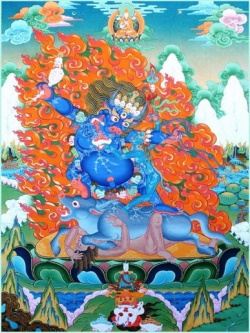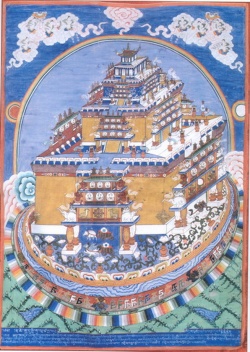Commenting by quoting The case of Manorathanandin’s Pramāṇavārttikavr̥tti
by Cristina Pecchia
Commentary as a genre designates in Indian literature, as it is well known, a great variety of texts, from original and highly innovative compositions to compilations of excerpts from various works. Not the least variegated of its aspects is the re-use of previous textual material, which can be distinguished in two types: the root-text and other sources. Commentaries were, then, a product of the quoting as much as of the explaining
I will illustrate this by examining the case of a commentary on Dharmakīrti’s Pramāṇavārttika (PV), namely, Manorathanandin’s Pramāṇavārttika-vr̥tti (PVV).
I shall examine the commentary on the Pramanasiddhi chapter of the PV, from kārikā 190 to 216, with the related glosses from Vibhūticandra, which are found in the manuscript that contains the PVV. This part of the PV and PVV contains a discussion related to the nirodhasatya, the truth concerning the cessation of suffering.
Dharmakīrti and Manorathanandin were active in South Asia.
They composed works in Sanskrit which belong to the Buddhist epistemological tradition.
The actual evidence we have about Dharmakīrti’s life is so lacunary that it does not allow us to draw any certain conclusion, but rather suggests to leave open the issue and consider the years 550-660, as some scholars have done, the span of time in which Dharmakīrti was possibly active.
Manorathanandin became known to modern scholars after Sāṅkṛtyāyana’s discovery of the PVV in the 1930s. Because no new evidence about Manorathanandin has emerged in the last decades, Sāṅkṛtyāyana’s statements on him remain valid: “We are quite in the dark about the time of Manorathanandin.
His name is not mentioned in any Tibetan work and the author himself does not give any clue to his identity. He does not mention the name of any other scholar from which we could infer 2 the precise time.
The present manuscript [of the PVV] was copied by Vibhūticandra, a pupil of Śākyaśrī (1127-1225 A.C.) who went to Tibet in 1203 A.C., so the lower limit of the period in which Manorathanandin flourished cannot be later than 1200 A.C.”1 Steinkellner and Much have tried to precise Manorathanandin’s date and milieu.
They have put his life span in the second half of the 11th century, based on Vibhūticandra’s chronology and a hypothetical identification of Manorathanandin with the Kāśmīri paṇḍita called Manoratha, who collaborated with the lotsāba rṄog Blo-ldan śes-rab (1059–1109) at the translation of Śaṅkaranandana’s Anyāpohasiddhi in Groṅ-khyer dpe-med, i.e. Anupamapura in Kaśmīr.
According to Jean Naudou’s judgement, the personality of this Manoratha appears rather mediocre in comparison with other more prominent Kāśmīri masters from the 11th century who collaborated with Tibetan masters in the translation of voluminous and difficult Buddhist works.
Vibhūticandra densely filled with annotations (short Glosses) the margins of the manuscript containing the PVV (short Vms), most probably after copying and revising the text of the PVV. He was born in the later half of the 12th century, in the area of northern Bengal known at that time as Varendra or Varendri.
He was active in the Vikramaśīla University, which he left with his teacher Śākyaśrībhadra (1140s-1225) in 1203 to travel to Tibet, where they presumably arrived in 1204. Information about Vibhūticandra’s life were provided by Sāṅkṛtyāyana, and have been more recently exhaustively collected and discussed by Cyrus Stearns, in his 1996 monographic article. Vibhūticandra was translator as well as author of many works concerning the kālacakratantra and, in particular, the practice of the ṣaḍaṅgayoga.
Plausibly in the days of his youth, as a disciple of Śākyaśrībhadra, he was given the task of making copies from extant manuscripts.
He was certainly the copyist of the manuscript of PVV, as the colophon attests: “likhiteyam paṃḍi(ta) vibhūticandreṇa”, and of a manuscript which bears part of the PVA.
1 PVVR, p. i.
3
The Pañjikā written by Devendrabuddhi (ca. 630-690) and the Alaṅkara by Prajñākaragupta (ca. 750-810) appear to be the main sources of reference for Manorathanandin.
Devendrabuddhi (ca. 630-690) composed the Pramāṇavārttikapañjikā (PVP) on chapter 2 to 4.
The work is extant only in the Tibetan translation (Tshad ma rnam ’grel gyi dka’ ’grel) from the half-11th century done by Subhūtiśrī and dGe ba’i blo gros.
From a chronological point of view, this is the closest commentary to the PV and the only one composed by Dharmakīrti’s direct pupil.
Prajñākaragupta (ca. 750-810) composed the Pramāṇavārttikālaṅkāra, also attested as Pramāṇavārttikālaṅkārabhāṣya, on the chapters 2 to 4.
Since Steinkellner’s proposal, especially editions published in Vienna contain a reference apparatus with the record of the relationship between a passage of the work under examination and another textual unit.
Such record is based on a classification consisting in four main categories, which have as their focus the text in the edited work.
This may be a citation from another external textual unit (Ce – citatum ex alio, etc.), or its source (Ci – citatum in alio – etc.); it may just report (Re – relatum ex alio) a content from another text, or be equivalent to another textual unit of the same author, either external or internal to the edited work (P – textus parallelus).
This kind of classification proves very useful in providing an immediate orientation when one consults an apparatus and, more in general, deals with references, but it is problematic from other points of view. In the first two categories a distinction is made when citations are marked or not marked as such, for example through iti.2
The presence of such markers and, more in general, the wording of a citation may however vary in different versions of the text, depending on transmissional factors3 and/or the intervention of the author of the citation itself. As a matter of fact, divergences (but also agreements) between a citation and the cited text as known to us are necessarily based on the extant witnesses only.
Accordingly, any assessment on the degree of agreement between a citation and its source is hypothetical. 2 See Steinkellner 1988 and more recently PVin 1-2: xxxv-vi. 3 See Lasic 2000: p. 26, n. 11.
4
has devoted a new global reflection on the issue in connections with the Jaina work Satyaśāsanaparīkṣā.
With regard to the Following Himal Trikha (2012, Part C), there are four possible modi of the relationship between the passages in the work under examination and other textual units that express the same, or similar, content. These modi are based on the verbal congruence; they are: (a) verbatim congruence (marked with =); (b) literal congruence with deviations (marked with ~); (c) loose verbal congruence with slight changes in the formulation (marked with #); (d) parallel content with independent formulation (marked with //).4
The categories (a) to (c) of this classification subsume the subdivisions of the categories created by Steinkellner, absorbing differences such as those determined by formal markers which explicitly mark a quotation, e.g. iti. In the reference apparatus, I have adopted this type of classification and the related set of symbols and abbreviations. Clear deviations in the textual units related to our passages are indicated by underlining the relevant portion of text.
Manorathanandin’s Pramāṇavārttikavr̥tti This is a list of texts very similar to the PVV text. Because they precede the PVV, they might have been the sources that Manoratha used composing his commentary.
k. 190
a – a ~ PVP 93b7: ji skad du bśad pa’i rgyu daṅ raṅ bźin gyi sdug bsṅal de daṅ | de ni rtag pa ma yin te | rgyun chad par srid pa’i chos can yin no | b – b ~ PVP 93b8: sogs pa smos pas ni ma tshaṅ ba srid pa’i phyir ro | c – c ~ PVA 136.26-27: nirodha eva nāstīti vādinaṃ prati nirodhata ity (PVAms : nirodhatā hy PVA) ucyate
4 Trikha 2012: 127: “Wortwörtliche Übereinstimmung … Wörtliche Übereinstimmung mit Abweichungen … Lose wörtliche Ubereinstimmung mit leichten Umformulierungen … Formulierungsunabhängige inhaltliche Parallelen”. 5
d – d ~ PVP 94a6-7: skyon de yod pa ma yin no | ci’i phyir źe na | ’dod ba ñid yin pa’i phir te ’khor ba can ’ga’ źig kyaṅ yod pa ma yin na [PVPD : no | PVPP] gaṅ ’khor ba las grol bar ’gyur | sdug bsṅal tsam ’ba’ źig po ’di rgyu daṅ bcas pa can ’jug par ’gyur ba daṅ | rgyu ma tshaṅ ba las res ’ga’ mi ’byuṅ ṅo źes kho bo smra’o |
k. 191
a – a ~ PVP 95a1: srog chags su mṅon par ’dod pa’i phuṅ po’i rgyun no || b – b ~ PVP 94b8: sdug bsṅal gyis gnas par ’gyur ro || k. 192
a – a ~ PVP 95a2: bdag la sogs pa ’ga’ źig go | b – b // PVA 137.19: na hi paramārthato vastv astīty etāvataiva tathā vyavahāraḥ | pratītyapekṣatvād vyavahārasya |
c – c // PVA 137.20: na paramārthataḥ sarpaḥ parihāraviṣayaḥ | api tu | sarpatayā vimokṣaviṣayaḥ |
d – d // PVA 137.18: abhimānāt sa eva badhyate sa eva muktimān iti e – e // NBṬ 28.3
f – f // PVV 106.9
g – g // AKBh 258.24
k. 193
a – a // AKBh 258.24
b – b ~ PVP 96a5: bdag ñid la phyin ci log gi śes pa daṅ srid pa la sred pa yin te |; // PV II.281ab
k. 194
a – a ~ PVP 96b5-6: mi rtag pa daṅ | sdug bsṅal ba daṅ | stoṅ ba daṅ bdag med pa b – b ~ PVP 96b6: sṅar yaṅ sñiṅ rje goms par byas śiṅ (see Vibhū. gl. 3, k. 194, in App. 1)
c – c // PVSV 9.12-14: asaty apy ātmagrahe...karuṇā |; // PVP 96b7: sdug bsṅal tsam mṅon du byed pa’i sgo nas ’jug pa’i phyir ro || brtse ba skye ba k. 195
a – a ~ PVP 97a1-2: rtag pa daṅ | bde pa daṅ | bdag daṅ bdag gi’i k. 197
a – a ~ PVP 97a8: gal te de lta yin na sṅon gyi las kyis ’phaṅs pas gźan gyi dbaṅ ñid yin pa’i phyir | de ñid kyi tshe mya ṅan las ’das par mi ’gyur ba de’i tshe | ’khor ba las grol ba ñid ma yin no
b – b c – c ~ PVP 97b1-2: sdug bsṅal gźan gyi rgyu ma tshaṅ bas ñid mtshams sbyor ba med pa’i phyir | […] grol ba ñid yin no || k. 198
a – a ~ PVA 139.17: na sadā tiṣṭhanti | b – b ~ PVP 98a2: dus thams cad du bźugs pa c – c ~ PVP 98a2: gaṅ dag sems can chen po rgyu med par mchog tu mñes gśin pa
k. 199
a – a ~ PVP 98a3-4: gal te ’jig rtshogs lta | yaṅ srid par ñid mtshams sbyor ba’i rgyud gyur pa daṅ bral ba’i phyir rgyun du źugs pa la sogs pa lam daṅ po ste | mthoṅ ba’i lam ñid gyis srid (srid PVPD : sred PVPP) med grol ba ñid du ’gyur na |
b – b c – c ~ PVP 98a5-6: bdag tu lta ba’i rnam pa gñis te | kun brtags (PVPD : btags PVPP) pa daṅ lhan cig skyes pa’o
6
k. 200
a – a ~ PVP 98a8-98b1: bdag tu lta ba lhan cig skyes ba gaṅ yin pa de ma (ma PVPD : om. PVPP) spaṅs pa yaṅ gaṅ yin źe na | k. 201
a – a~ PVA 140.9
b – b ~ PVP 98b4: rgyun du źugs pa … || de bas na sems can du lta ba lhan cig skyes pa ma spaṅs yin no ||
k. 202
a – a // TS 499ab
b – b = HB 19*.12
k. 203
a – a ~ PVP 99b3-4: gal te rtag pa la [PVPP : las PVPD] ’chiṅ ba daṅ thar pa yod pa ma yin pa de ltar ni ’dod pa ñid yin mod kyi | rtag pa daṅ mi rtag pa ñid du brjod du med pa’i gaṅ zag bciṅs pa daṅ thar par khas len pa’i phyir ro źe na | b – b ~ PVP 99b7: de ni med pa ñid yin no || (the logical subject of the paragraph is gaṅ zag, i.e. pudgala, in 99b5-6)
c – c // PVP 99b4-5: rtag pa daṅ mi rtag pa dag ni phan tshun spaṅs te | gnas pa’i mtshan ñid can yin pa’i phyir ro | dṅos po la gcig rnam par [PVPD : phar PVPP] gcad [PVPD : bcad PVPP] pa daṅ | yoṅs su gcod pa dag ni de las gźan yoṅs su gcod pa daṅ | rnam par gcad pa med na mi ’byuṅ ba ñid yin pa’i phyir ro || d – d ~ PVA 142.24: na nityānityasya vastunaḥ saṃbhavaḥ kvacit || e – e ~ PVP 99b8: de bas na gaṅ zag yod pa ñid ma yin pa [PVPD : yod pa PVPP] des na ...
k. 204
a – a ~ PVP 100a1: gal te rtag pa ñid du brjod par bya ba ñid ma yin pa’i phyir skyon med do źe na |
b – b ~ PVP 100a4: gaṅ zag tu sgro btags pa’i | lta ... c – c ~ PVP 100a5: gaṅ zag de ni ... brjod k. 205
a – a ~ PVP 100a6-7: ston pa’i tshig bśad pa’i skabs su ji ltar bdag med pa ñid mthoṅ bas (bas PVPP : ba PVPD) goms pa’i mtshan ñid can ’di ni thabs goms pa ñid yin no źes bya bas | bśad zin (PVPP : zin to PVPD) lam | (see Vibhū. gl. 1, k. 205, in App. 1)
b – b ~ PVP 100b2-3: lam goms pa la gnas pa’i sems la ñes pa rnams yaṅ ’byung pa’i nus pa yod pa ma yin no ||. // PVA 144.17f. k. 206
a – a ~ PVP 102a3-4: yul de ni yul can gyi rnam par śes pa de’i skyed par byed pa yin par ’dod do ||
k. 207
a – a ~ PVP 102b2-3: ’di ltar raṅ bźin ji lta ba bźin du raṅ ’dzin pa’i śes pa skyed par byed pa de ni yul gyi raṅ bźin yin la yul can gyi yaṅ yaṅ dag pa’i yul gyi rnam par rtog pa gaṅ yin pa de ni raṅ bźin yin no | b – b ~ PVP 102b5: raṅ bźin rnam pa gźan du ’gyur pa’i ldog pa’i rgyu mtshan gyis rkyen la bltos pa yin te |
c – c // PVin 16.xx = PVA 143.7: ākārārpaṇakṣamaṃ hi kāraṇaṃ vijñānasya viṣayaḥ |; // PV III.247b-d: grāhyatāṃ viduḥ hetutvam eva yuktijñā jñānākārārpaṇakṣamam ||
k. 208
7
a – a ~ PVP 103a2: rkyen gźan gyi rgyu mtshan las ’oṅs pa ñid yin pa’i phyir | glo bur ba yin gyi de’i raṅ bźin ni ma yin no || b – b ~ PVA 144.12: śrutacintākāle
c – c ~ PVP 103a5: de’i raṅ bźin lam k. 209
a – a ~ PVP 103a7-103b1: sems kyi rgyun źes bya ba’i dṅos po la’o || ci ’dra ba źig ce na | gnod pa can | skyed nus sñiṅ po can te | bdag med pa ñid mthoṅ ba’i mtshan ñid can gyi lam ’khrul pa la gnod pa can skyed pa de’i nus pa de ñid sñiṅ po ste |
k. 210
a – a ~ PVP 104a4: des ni tshad ma’i grogs can ñid yin par bśad do || b – b ~ PVA 144.22: sātmībhūtanairātmyadarśanasya b – c ~ PVP 104a2: ñes pa’i gñen po’i phyogs su gyur pa yon tan daṅ ldan pa’i lam gyi phyogs ’dsin pa’i rgyu’i phyir |; // PVSV 111.9: guṇapakṣapātena; // PVA 144.21: guṇapakṣapātāt
k. 211
a – a // PVA 144.29-30: nanu ca rāgadveṣayor viparītākāratve ’pi naikasyaiva bādhā | … tathā nairātmyātmadarśanayor api syāt | b – b ~ PVP 104b3-4: gaṅ la bdag tu chags pa de (de PVPD : om. PVPP) ñid la yaṅ de la gnod pa byed pa la źe sdaṅ bar ’gyur ba de ltar na | k. 212
a – a ~ PVP 104b8: byams pa daṅ mi gtsaṅ ba la sogs pa ni źe sdaṅ la sogs pa’i gñen (PVPD : gñan PVPP) por gyur pa yin na ci’i phyir ñes pa śin tu rgyun gcod par mi ’dod ce na bśad ba |; // PVA 145.9-10 b – b ~ PVP 105a3: de ltar na ñes pa rnams kyi rgyu la gnod pa med pa’i phyir | ñes pa rnams śin tu rtsa ba nas ’don pa ma yin pa’i phyir | c – c ~ PVA 145.12: sa eva mohaḥ satkāyadarśanam k. 213
a – a ~ PVP 105a8-105b1: ’jig tshogs su lta ba ni don phyin ci log tu rtogs ba’i ṅo bo can yin źiṅ | mi śes pa mi gsal (gsal PVPD : bsal PVPP) ba’i ṅo bo ni gźan ñid yin na de ji ltar na gti mug de yaṅ ’jig tshogs lta ba yin źes; // PVA 145.16-17: nanv asaṃprakhyānarūpā ’vidyā satkāyadarśanaṃ tu pratipattirūpaṃ tat kathaṃ satkāyadarśanam evāvidyeti | b – b ~ PVP 105b4: gzugs la sogs pa yaṅ | c – c ~ PVA 145.24 ~ AK III.28cd: vidyāvipakṣo dharmo ’nyo ’vidyā ’mitrānṛtādivat |
d – d ~ PVP 106a5-7: sems las byuṅ ba yin pa’i rgyu ñid kyis dmigs pa ste | e – e ~ PVA 146.3-4; ~ PVP 106a6-7: rten daṅ dmigs pa daṅ rnam pa daṅ dus daṅ rdzas mtshuṅs par ldan pa’i phyir mtshuṅs par ldan pa yin par ’dod do |; ~ AKBh 62.7-9: saṃprayuktāḥ samaṃ prayuktatvāt. kena prakāreṇa samaṃ prayuktā ity āha pañcadhā (II.34d) pañcabhiḥ samatāprakārair āśrayālambanākārakāladravyasamatābhiḥ | f – f ~ PVP 106b3: bcom ldan ’das
g – g ~ PVA 146.5-7: tatra tatra sūtra uktāḥ | tatra katamo ’jñānavigamo yo yathābhūtānāṃ dharmāṇām adhyāropādhigamaḥ | tathā yāḥ kāścana lokopacāropapattayaḥ ... °vigamato (Ams : °nigamato AE) na bhavanti; ~ PVP 106b5-7: de skad du sa bcu pa’i mdo las de ’jig rten gyi ’byuṅ daṅ | ’jig pa las rnam par lta bu’i tshe ’di sñam du sems te | ’jig rten du ’dogs pa ’byuṅ ba ji sñed pa de dag thams cad ni | bdag tu mṅon par źen pa las ’byuṅ ste (ste PVPP : 8
om. PVPD) | bdag tu mṅon par źen pa daṅ bral na ’byuṅ ba yaṅ med par ’gyur ro sñam mo ||; =Bhagavatā ?
k. 214
a – a ~ PVP 107a7: gal te ’jig rtshogs su lta ba ñid ma rig pa yin pa de’i tshe lta ba daṅ mtshuṅs par ldan pa (pa PVPD : pa’i PVPP ) ma rig pa yin no źes bya ba’i mtshuṅs par ldan pa’i don ’thad pa ma yin te | b – b ~ PVA 146.15-16: tathā yady avidyā dṛṣṭir eva tadā [...] saṃprayuktaḥ | c – c // PVA 146.14: nanu satkāyadṛṣṭir mohajadeśabhūtā | mohas tu sakalakleśānugato ’saṃprakhyānalakṣaṇo ’nyathā vā sa kathaṃ satkāyadṛṣṭir ucyate |
d – d ~ PVP 107b3: de’i phyogs gcig pa’i ṅo bo ni ’jig rtshogs su lta ba yin no | e – e ~ PVA 146.20-22: sāmānyaviśeṣabhāvena hi bhedakalpanayā saṃprayuktārthaḥ | tadyathā palāśayuktaṃ vanam iti | [...] tatsvabhāvā (tatsvabhāvā Ams : tatsvabhāvo AE) ’vidyā nidānabhūtā prādhānyena nirdiṣṭā | (see Vibhū. gl. 1, k. 214, in App. 1)
f – f ~ PVP 107b4-5: stoṅ ñid lta daṅ de ’gal phyir | bdag med pa ñid mthoṅ ba ni bdag tu lta ba daṅ ’gal ba’i phyir ro || de’i raṅ bźin te […] bdag tu lta ba las byuṅ ba’i […] ñes kun daṅ
g – g ~ PVP 107b6-7: dper na graṅ ba daṅ ’gal ba’i me ni […] graṅ ba’i ’bras bu spu loṅ źes |
h – h ~ PVP 108a2-3: de ltar na bdag med par lta ba […] bdag ñid du gyur ba yod na | skyon rnams kyaṅ ’jug pa med pa’i chos can ñid yin no | i – i ~ PVA 146.24: tato niḥsaraṇākāratā nirodhasya kathitā | k. 215
a – a ~ PVP 108a7-8: gtan tshigs ’di ma grub daṅ | srog chags ’ga’ źig kyaṅ yod pa ma yin na | gaṅ gi ’dod chags la sogs pa ’di chos yin | b – b ~ PVP 108b6: mṅon du gyur pa yod na | k. 216
a – a // PVP 109a1: de ltar ni ’gyur mod kyi ji ltar zaṅs ma la sogs pa’i sra ba’i mi mthun pa’i phyogs me (me PVPD : om. PVPP) mṅon du gyur pa las źu bar gyur pa (las źu bar gyur pa PVPD : om. PVPP) na sra ba ñid med du zin kyaṅ | yaṅ ’byuṅ ba ñid yin pa de daṅ ’dra ba gñen po’i phyogs mṅon du gyur pa log pa na yaṅ ñon moṅs pa rnams yaṅ ’byuṅ ba’i chos ñid yin no ||
Vibhūticandra
This is a list of texts very similar to those of Vibhūticandra’s glosses. Because these texts were composed before Vibhūticandra copied the manuscript containing the PVV, they might have been the sources that Vibhūticandra used composing his commentary. 9
k. 190, gl. 1 samudaya (om. VR H; see note on kāraṇa, at 190.1, in App. 3) (N)
k. 194, gl. 1 dveṣo hi kṛpāvirodhī sa prahīṇadveṣaḥ (# VR 78, n. 1) // PVP 96b6: źe sdaṅ spaṅgs pa can gyi rgyud ’gal ba med pa’i rtse ba skye ba k. 194, gl. 3 karuṇāyāḥ ms; karuṇāy(āḥ) H; karuṇāyā | VR (= VR 78, n. 2) (N)
~ PVP 96b6 (see citation note b-b, k. 194)
k. 194, gl. 4 etena dharmālambanī kṛpoktā (= VR 78, n. 3) // PVṬ 24a4: chos la dmigs pa dag kyaṅ srid pa'i phyir te ~ PVVṬ 52.13f.: dharmālambanānām api saṃbhavāt.
k. 195, gl. 2 iti rāgād anyā kṛpā (~ VR 78, n. 5); // PVA 138.22: dayāyā rāgasya ca mahān bhedaḥ |
k. 205, gl. 1 upāyābhyāsa evāyaṃ tādarthyāc chāsanaṃ matam ity anena ms; [...] tādātmyāc [...] VR H (~ VR 81, n. 2, first part) (N)
= PV II.138ab; ~ PVP 100a7 (see citation note a-a) k. 205, gl. 2 nairātmyaṃ prakṛtiḥ pramāsi[ddhaṃ]〈ddhā〉 | | prakṛtiśuddhahemavat ms; [...] pramāsiddhiḥ | [...] VR; [...] pramāsiddha(ḥ) [...] H (# VR 82, n. 5, second part, and 82, n. 1; H reads the first part of this gloss together with gloss 21, and the second part as a separate gloss, as in VR (N) ~ PVP 100b7: dper na gser raṅ bźin gyis rnam par dag pa | k. 206, gl. 1 arthagrāhijñānam icchato vaktavyaḥ (~ VR 82, n. 2) ~ PVP 101a3: don dam par rnam par śes pa ni don ’dzin par ’dod pas | rnam śes yul ’dzin pa’i chos źes (źes PVPD : śes PVPP) brjod par bya’o || k. 207, gl. 3 mandamandaprakāśe sarpocite pradeśe VR H; [...] sarpyocite [...] ms (# VR 82, n. 4)
~ PVP 101a6: sbrul du ’dris pa’i phyogs mi gsal bar; // PVV 207.19. k. 209, gl. 1 nityam udakasrāviṇyāṃ (~ VR 83, n. 1) ~ PVP 103b1: ji ltar rtag tu chus bṅas ba’i raṅ bźin gyi sa la | k. 213, gl. 5 avidyāyāḥ (= VR 85, n. 5) ~ PVP 106a5: ma rig pa ni sems la byuṅ ba’i chos yin no || k. 214, gl. 1 yathā palāśādiyuktaṃ vanaṃ pāṇyādiyuktaṃ śarīram (~ VR 85, n. 10)
~ PVP 107b1: dper na pa la śa la sogs pa daṅ ldan pa’i nags daṅ | lus lag pa la sogs pa daṅ ldan pa źes bya ba lta bu’o | k. 214, gl. 6 yataś caivam ātmadarśanaprabhūtāḥ sarvakleśāḥ (om. VR H, // note on āha, at 214.9, in App. 3) (N)
~ PVP 107b4: gaṅ gi phyir de ltar bdag tu lta ba las byuṅ ba’i skyon thams cad ni |
10
Abbreviations
App. Apparatus
gl. gloss
k. kārika
Abbreviations of books
AKBh Abhidharmakośabhāṣya of Vasubandu: Abhidharmkoshabhāṣya of Vasubandhu, ed. P. Pradhan. (Tibetan Sanskrit Works Series VIII] K. P. Jayaswal Research Institute, Patna 1967. D sDe dge edition, Tibetan Tripiṭaka bsTan ḥgyur: xxx P Peking edition, Tibetan Tripiṭaka bsTan ḥgyur: Daisetz T. Suzuki, The Tibetan Tripitaka. Peking Edition, Kept in the Library of the Otani University, Kyoto. 168 vols. Tibetan Tripitaka Research Institute, Kyoto-Tokyo 1955-1961.
PV Pramāṇavārttika of Dharmakīrti: for chapter I (= Svārthānumāna), see PV I. For chapters II (= Pramāṇasiddhi), III (= Pratyakṣa), IV (= Parārthānumāna), see PVM. The numbering of the kārikās is according to the numeration established by Vetter 1964: xxx (see Introduction, p. xx)
PVA Pramāṇavārttikabhāṣya of Prajñākaragupta: Pramāṇavārtikabhāshyam or Vārtikālaṅkāraḥ of Prajñākaragupta (Being a commentary on Dharmakīrti’s Pramāṇavārtikam), ed. Rāhula 11
Sāṅkr̥tyāyana. (Tibetan Sanskrit Works Series 1] Kashi Prasad Jayaswal Research Institute, Patna 1953.
PVṬ Pramāṇavārttikaṭīkā of Śākyabuddhi: Tibetan translation in D 4220, P 5718.
PVP Pramāṇavārttikapañjikā of Devendrabuddhi: Tibetan translation in D 4217, P 5717.
VR Pramāṇavārttika of Acharya Dharmakirtti with the Commentary ‘Vṛtti’ of Acharya Manorathanandin, ed. R. Sāṅkṛtyāyana. Appendix to JBORS 24, Part III and IV, pp. 1-136, JBORS 25, Part I to IV, pp. 137-480, and JBORS 26, Part I and II, pp. 481-531, Patna 1938- 1940.
H Haiyan Hu-von Hinüber, Marginalien in der Sanskrit- Handschrift von Manorathanandins Pramāṇa-vārttikavr̥tti. Wien 1995. Revised by Horst Lasic. Wien 1995/96. Unpublished manuscript. HB Hetubindu of Dharmakīrti: Ernst Steinkellner, Dharmakīrti's Hetubinduh. Teil I, Tibetischer Text und rekonstruierter Sanskrit-Text. VÖAW, Wien 1967.







